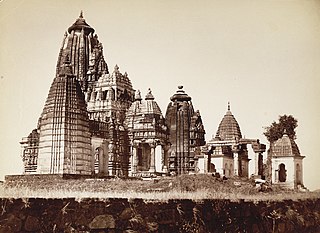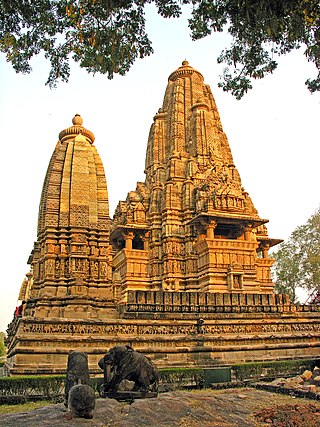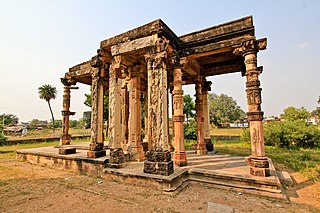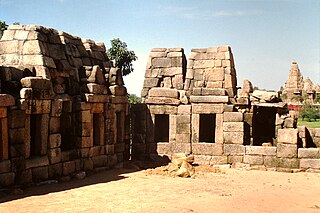History
The Devi Jagadambi Temple is one of the Khajuraho group of monuments that were built during the rule of the Chandela dynasty. The building activity started almost immediately after the rise of their power, throughout their kingdom to be later known as Bundelkhand. [4] Most temples were built during the reigns of the Hindu kings Yashovarman and Dhanga. Yashovarman's legacy is best exhibited by the Lakshmana Temple. Vishvanatha temple best highlights King Dhanga's reign. [5] : 22 The largest and currently most famous surviving temple is Kandariya Mahadeva built in the reign of King Vidyadhara. The temple inscriptions suggest many of the currently surviving temples were complete between 970 and 1030 CE, with further temples completed during the following decades. [7]
The first documented mention of Khajuraho was made in 641 by Xuanzang, a Chinese pilgrim who described encountering several dozen inactive Buddhist monasteries and a dozen Hindu temples with a thousand worshipping brahmins. [8] In 1022 CE, Khajuraho was mentioned by Abu Rihan-al-Biruni, the Persian historian who accompanied Mahmud of Ghazni in his raid of Kalinjar; he mentions Khajuraho as the capital of Jajahuti. [9] The raid was unsuccessful, and a peace accord was reached when the Hindu king agreed to pay a ransom to Mahmud of Ghazni to end the attack and leave. [10]
Khajuraho temples were in active use through the end of the 12th century. This changed in the 13th century; after the army of Delhi Sultanate, under the command of the Muslim Sultan Qutb-ud-din Aibak, attacked and seized the Chandela kingdom. About a century later, Ibn Battuta, the Moroccan traveller in his memoirs about his stay in India from 1335 to 1342 CE, mentioned visiting Khajuraho temples, calling them "Kajarra" [11] [12] as follows:
...near (Khajuraho) temples, which contain idols that have been mutilated by the Moslems, live a number of yogis whose matted locks have grown as long as their bodies. And on account of extreme asceticism they are all yellow in colour. Many Moslems attend these men in order to take lessons (yoga) from them.
—
Ibn Battuta, about 1335 CE, Riḥlat Ibn Baṭūṭah, Translated by Arthur Cotterell [13]
The central Indian region, where Khajuraho temples are, was controlled by various Muslim dynasties from the 13th century through the 18th century. In this period, some temples were desecrated, followed by a long period when they were left in neglect. [7] [4] In 1495 CE, for example, Sikandar Lodi's campaign of temple destruction included Khajuraho. [14] The remoteness and isolation of Khajuraho protected the Hindu and Jain temples from continued destruction by Muslims. [15] [16] Over the centuries, vegetation and forests overgrew the temples.
In the 1830s, local Hindus guided a British surveyor, T.S. Burt, to the temples and they were thus rediscovered by the global audience. [17] Alexander Cunningham later reported, few years after the rediscovery, that the temples were secretly in use by yogis and thousands of Hindus would arrive for pilgrimage during Shivaratri celebrated annually in February or March based on a lunar calendar. In 1852, F.C. Maisey prepared earliest drawings of the Khajuraho temples. [18]

The Khajuraho Group of Monuments are a group of Hindu and Jain temples in Chhatarpur district, Madhya Pradesh, India. They are about 175 kilometres (109 mi) southeast of Jhansi, 10 kilometres (6.2 mi) from Khajwa, 9 kilometres (5.6 mi) from Rajnagar, and 49 kilometres (30 mi) from district headquarter Chhatarpur. The temples are famous for their Nagara-style architectural symbolism and a few erotic sculptures.

The Gurjara-Pratihara was a dynasty that ruled much of Northern India from the mid-8th to the 11th century. They ruled first at Ujjain and later at Kannauj.

The Chandelas of Jejakabhukti was an Indian dynasty in Central India. The Chandelas ruled much of the Bundelkhand region between the 9th and the 13th centuries. They belonged to the Chandel clan of the Rajputs.

The Kandariya Mahadeva Temple, meaning "the Great God of the Cave", is the largest and most ornate Hindu temple in the medieval temple group found at Khajuraho in Madhya Pradesh, India. It is considered one of the best examples of temples preserved from the medieval period in India. Because of its outstanding preservation and testimony to the Chandela culture, the temple was inscribed on the UNESCO World Heritage List in 1986.

The Jain temples of Khajuraho are a part of the UNESCO World Heritage Site of Khajuraho. They are located in Chhatarpur district, Madhya Pradesh, India, about 175 kilometres southeast of the city of Jhansi.

The history of Madhya Pradesh can be divided into three periods - the ancient period, the medieval period and modern period.

Khajuraho is a city, near Chhatarpur in Chhatarpur district of the Indian state of Madhya Pradesh. One of the most popular tourist destinations in India, Khajuraho has the country's largest group of medieval Hindu and Jain temples, famous for their erotic sculptures. The Khajuraho Group of Monuments has been listed as a UNESCO World Heritage Site since 1986 and is considered one of the "seven wonders" of India. The town's name, anciently "Kharjuravahaka", is derived from the Sanskrit word kharjur meaning "date palm".

Chaturbhuj Temple is a temple dedicated to the Hindu god Vishnu in Khajuraho, India in the village of Jatakari. It is also known as Jatakari Temple.

The Duladeo Temple is a Hindu temple in Khajuraho, Madhya Pradesh, India. The temple is dedicated to the god Shiva in the form of a linga, which is deified in the sanctum. 'Dulodeo' means "Holy Bridegroom". The temple is also known as "Kunwar Math". The temple faces east and is dated to 1000–1150 AD. It is the last of the temples built during the Chandela period. The temple is laid in the seven chariot plan (saptarata). The figurines carved in the temple have soft expressive features unlike other temples. The walls have a display of carved celestial dancers (apsara) in erotic postures and other figures. As part of the Khajuraho Group of Monuments, the temple was inscribed on the UNESCO World Heritage List in 1986.

The Lakshmana Temple is a 10th-century Hindu temple built by Yashovarman during the Chandela dynasty located in Khajuraho, India. It is dedicated to Vaikuntha Vishnu - an aspect of Vishnu. As part of the Khajuraho Group of Monuments, and owing to its architecture and religious importance, the temple was inscribed on the UNESCO World Heritage List in 1986.

Vamana temple is a Hindu temple dedicated to Vamana, an avatar of the god Vishnu. The temple was built between 1050 and 1075. It forms part of the Khajuraho Group of Monuments, a UNESCO World Heritage Site listed because of its exceptional architecture, art, and testimony to the Chandela dynasty.
Vidyadhara was a Chandela king of central India. He ruled in the Jejakabhukti region. Vidyadhara was the successor of Ganda, and expanded the Chandela power between Chambal river in the northwest and Narmada River in south.

The Vishvanatha Temple is a Hindu temple in Madhya Pradesh, India. It is located among the western group of Khajuraho Monuments, a UNESCO World Heritage site. The temple is dedicated to Shiva, who is also known as "Vishvanatha", meaning "Lord of the Universe".
Ganda was an early 11th century king of the Chandela dynasty of India. He ruled in the Jejakabhukti region. The exact period of his reign is uncertain, but has been dated approximately as 999-1002 CE.
Dhanga, also known as Dhaṇgadeva in inscriptions, was a king of the Chandela dynasty of India. He ruled in the Jejakabhukti region. Dhanga established the sovereignty of the Chandelas, who had served as vassals to the Pratiharas until his reign. He is also notable for having commissioned magnificent temples at Khajuraho, including the Vishvanatha temple.
Harsha, also known as Shri Harsha, was a king of the Chandela dynasty of India. He ruled in the Jejakabhukti region.

Yashovarman, also known as Lakshavarman, was a king of the Chandela dynasty of India. He ruled in the Jejakabhukti region. He practically established the Chandelas as a sovereign power, although he formally acknowledged suzerainty of the Gurjara-Pratiharas. His major military achievement was the conquest of Kalanjara. He is also notable for having commissioned the Lakshmana Temple at Khajuraho.

Parshvanatha temple is a 10th-century Jain temple at Khajuraho in Madhya Pradesh, India. It is now dedicated to Parshvanatha, although it was probably built as an Adinatha shrine during the Chandela period. Despite the temple's Jain affiliation, its exterior walls feature Vaishnavaite themes. The entrance has an inscription with a most-perfect magic square. It is part of a UNESCO World Heritage Site along with other temples in the Khajuraho Group of Monuments, because of its outstanding art, architecture, and testimony of the Chandela period.

The Ghantai temple, also known as the Ghanti temple, is a ruined Jain temple in the Khajuraho town of Madhya Pradesh, India. Similar in style to the Parshvanatha temple, it was dedicated to the Jain tirthankara Rishabhanatha. This temple is part of UNESCO World Heritage Site along with other temples in Khajuraho Group of Monuments.

The Chausath Yogini temple is a ruined Yogini temple in the Khajuraho town of Madhya Pradesh, India. Dated to the late 9th century, it is the oldest surviving temple at Khajuraho. Unlike the Yogini temples at other places, it has a rectangular plan, but like them it is hypaethral, open to the air. As part of the Khajuraho Group of Monuments, and because of its unique Chandela architecture, the temple was inscribed on the UNESCO World Heritage List in 1986.

















